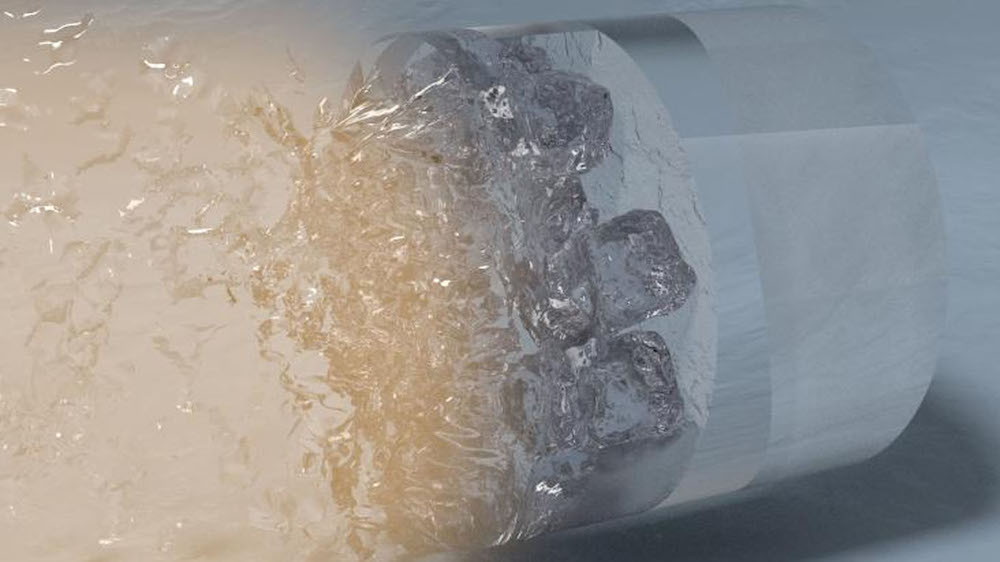Create a free profile to get unlimited access to exclusive videos, sweepstakes, and more!
Hot superionic ice is the newest state of matter and a huge oxymoron
As if the thought of scorching black ice isn’t weird enough, it now exists as a new state of matter.

Superhot ice? It might seem impossible, but there actually is a way to get water to morph into that if you have lasers powerful enough.
As if the thought of scorching ice isn’t weird enough, it might already exist on Uranus, Neptune, and possibly other planets that orbit alien stars. Just heat water to several thousand degrees while applying extreme pressure. Of course, this sounds easier than it actually is, but scientists from the Lawrence Livermore National Laboratory (LLNL), UC Berkeley, and University of Rochester were able to pull off creating this exotic state of H2O for the first time ever.
Superionic ice was only a hypothesis until now. Exposing water to pressures and temperatures that high makes hydrogen ions (atoms that have gained or lost electrons) move like a liquid inside solid oxygen. LLNL physicist Marius Millot led a study, recently published in Nature Physics, that reveals exactly how he and his research team were able to create a state of matter that could only be imagined when it was first predicted back in 1988.
“The combination of high pressure, equaling that of around 1-2 million atmospheres, and extremely high temperatures above 3,140 degrees Fahrenheit modify the properties of water and lead to the emergence of the superionic behavior,” Millot told SYFY WIRE.
To bring water to this bizarre state, the team began by compressing water into one of its crystalline forms (ice VII), an ice that differs from ice as we know it because it forms cubic instead of hexagonal crystals. This ice is also 60% denser than water at the pressure and temperature of whatever is surrounding it (liquid water is normally 10% denser than its frozen form). The pre-compressed ice was then zapped with six powerful lasers for shock compression, which sent intense shock waves through it, simultaneously compressing and heating.
Less shock heating is needed for pre-compressed ice. When shock waves zoom through a substance, they ramp up not just the pressure but also the density and inertial energy — the same energy that keeps things moving at the same rate and not flying off the planet — of that substance. Shock waves will also have a greater effect on materials that are more easily compressed. Pre-compressing the ice made it easier to turn it into something even denser, which was then measured by interferometric ultrafast velocimetry and pyrometry.
“Ultrafast velocimetry can determine the shock wave’s speed as it travels through the sample,” said Millot. “Using an interferometer allows for very precise measurements of the shock speed, while pyrometry looks at how the sample glows once it is shock-compressed and becomes hot.”
Velocimetry tracks particles to measure the speed of sound in fluids — hydrogen ions in superionic ice behave like a fluid — and an interferometer figures out measurements of speed by using the interference between at least two beams of light. An interferometric velocimeter has the strengths of both. This made it possible for the researchers to use the reflection and absorption of the laser light that was aimed at the shocked material to measure the material’s visible properties. It also brought the electrical properties of the dark superionic ice to light.
Pyrometry was also needed to thoroughly investigate the thermodynamic properties of superionic ice. It analyzed the wavelengths of the thermal radiation emitted by this new state of matter to determine its temperature. The reason this scorching ice appears black is because it has the same tendency to absorb optical light as other dark objects and substances.
Now that superionic ice has been brought into being, it has shown to exist at temperatures comparable to those of Earth’s core. Because it behaves like a liquid on the molecular level, it can tolerate higher temperatures in planetary cores without melting. Could it be out there in Neptune, Uranus, and faraway exoplanets that may or may not have been discovered yet? Millot is excited about the possibilities.
“Our experimental discovery of superionic water ice opens the way to imagining new kinds of water-rich planets with mostly frozen interiors,” he said. “It could dominate the interiors of Neptune and Uranus which offers a plausible origin to their unique magnetic fields.”
Between burning black ice and the frozen type that is the bane of winter, the hot stuff is definitely much cooler.


























